air condition MITSUBISHI LANCER 2014 8.G User Guide
[x] Cancel search | Manufacturer: MITSUBISHI, Model Year: 2014, Model line: LANCER, Model: MITSUBISHI LANCER 2014 8.GPages: 434, PDF Size: 57.5 MB
Page 125 of 434

Starting and stopping the engine 5-58 Features and controls
5
6. On vehicles with manual transaxle, place the gearshift lever in the ‚ÄúN‚ÄĚ (Neutral) position. On vehicles with continuously variabletransmission (CVT) or Twin Clutch SST, make sure the selector lever (CVT) or gearshift lever (Twin Clutch SST) is in the‚ÄúP‚ÄĚ (PARK) position. 7. Turn the ignition switch to the ‚ÄúON‚ÄĚ posi- tion and make certain that all warning lights are functioning properly beforestarting the engine. 8. Turn the ignition switch to the ‚ÄúSTART‚ÄĚ position without pressing the acceleratorpedal. Release the key when the engine starts.
After several attempts, you may experience that the engine still does not start. 1. Make sure that all electric devices, such as lights, air conditioning blower and rear window defogger, are turned off. 2. While depressing the brake pedal on vehi-cles equipped with continuously variable transmission (CVT) or Twin Clutch SST or the clutch pedal on the vehiclesequipped with manual transaxle, press the accelerator pedal halfway and hold it there, then crank the engine. Release theaccelerator pedal, immediately after the engine starts.
3. If the engine still will not start, the engine could be flooded with too much gasoline. While depressing the brake pedal on vehi- cles equipped with CVT or Twin ClutchSST or the clutch pedal on the vehicles equipped with manual transaxle, push the accelerator pedal all the way down andhold it there, then crank the engine for 5 to 6 seconds. Return the ignition switch to the ‚ÄúLOCK‚ÄĚ position and release theaccelerator pedal. Wait a few seconds, andthen crank the engine again for 5 to 6 sec- onds while depressing the brake pedal or the clutch pedal, but do not push theaccelerator pedal. Release the ignition key if the engine starts. If the engine fails to start, repeat these procedures. If theengine still will not start, contact your local Mitsubishi Motors dealer or a repair facility of your choice for assistance.
When the ambient temperature is -4 ¬įF (-20 ¬įC) or lower on vehicles with CVT, or -22 ¬įF (-30 ¬įC) or lower on vehicles with TwinClutch SST, it may not be possible to start
NOTE
ÔĀ¨ On vehicles with CVT, the starter will not operate unless the selector lever is in the ‚ÄúP‚ÄĚ(PARK) or ‚ÄúN‚ÄĚ (NEUTRAL) position. On vehicles with Twin Clutch SST, the starter will not operate unless the gearshiftlever is in the ‚ÄúP‚ÄĚ (PARK) position or the gearshift lever is in the ‚ÄúN‚ÄĚ (NEUTRAL) position with the brake pedal depressed.For safety reasons, start the engine in the ‚ÄúP‚ÄĚ (PARK) position so that the wheels are locked.
NOTE
ÔĀ¨ Minor noises may be heard on engine start- up. These will disappear as the engine warms up.
When the engine is hard to start
Startability of continuously vari- able transmission (CVT) vehicles or Twin Clutch SST vehicles at extremely cold ambient tempera- ture
Page 137 of 434
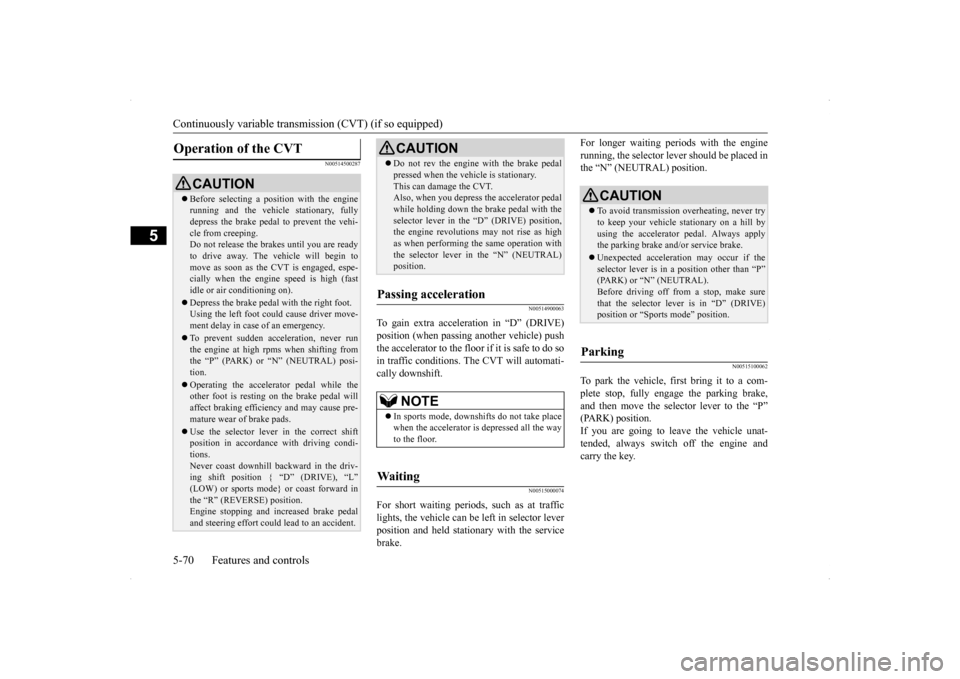
Continuously variable transm
ission (CVT) (if so equipped)
5-70 Features and controls
5
N00514500287
N00514900063
To gain extra acceleration in ‚ÄúD‚ÄĚ (DRIVE) position (when passing another vehicle) push the accelerator to the floor if it is safe to do so in traffic conditions. The CVT will automati-cally downshift.
N00515000074
For short waiting periods, such as at traffic lights, the vehicle can be left in selector lever position and held stationary with the servicebrake.
For longer waiting periods with the engine running, the selector lever should be placed in the ‚ÄúN‚ÄĚ (NEUTRAL) position.
N00515100062
To park the vehicle, first bring it to a com- plete stop, fully engage the parking brake,and then move the selector lever to the ‚ÄúP‚ÄĚ (PARK) position. If you are going to l
eave the vehicle unat-
tended, always switch off the engine and carry the key.
Operation of the CVT
CAUTIONÔĀ¨ Before selecting a position with the engine running and the vehicle stationary, fully depress the brake pedal to prevent the vehi- cle from creeping.Do not release the brakes until you are ready to drive away. The vehicle will begin to move as soon as the CVT is engaged, espe-cially when the engine speed is high (fast idle or air conditioning on).ÔĀ¨ Depress the brake pedal with the right foot. Using the left foot could cause driver move- ment delay in case of an emergency.ÔĀ¨ To prevent sudden acceleration, never run the engine at high rpms when shifting fromthe ‚ÄúP‚ÄĚ (PARK) or ‚ÄúN‚ÄĚ (NEUTRAL) posi- tion.ÔĀ¨ Operating the accelerator pedal while the other foot is resting on the brake pedal will affect braking efficiency and may cause pre-mature wear of brake pads.ÔĀ¨ Use the selector lever in the correct shift position in accordance with driving condi- tions. Never coast downhill backward in the driv- ing shift position { ‚ÄúD‚ÄĚ (DRIVE), ‚ÄúL‚ÄĚ (LOW) or sports mode} or coast forward inthe ‚ÄúR‚ÄĚ (REVERSE) position. Engine stopping and increased brake pedal and steering effort could lead to an accident.
ÔĀ¨ Do not rev the engine with the brake pedal pressed when the vehicle is stationary. This can damage the CVT. Also, when you depress the accelerator pedal while holding down the brake pedal with theselector lever in the ‚ÄúD‚ÄĚ (DRIVE) position, the engine revolutions may not rise as high as when performing the same operation withthe selector lever in the ‚ÄúN‚ÄĚ (NEUTRAL) position.
Passing acceleration
NOTE
ÔĀ¨ In sports mode, downshifts do not take place when the accelerator is depressed all the way to the floor.
Wa i t i n g
CAUTION
CAUTIONÔĀ¨ To avoid transmission overheating, never try to keep your vehicle stationary on a hill by using the accelerator pedal. Always apply the parking brake and/or service brake.ÔĀ¨ Unexpected acceleration may occur if the selector lever is in a position other than ‚ÄúP‚ÄĚ(PARK) or ‚ÄúN‚ÄĚ (NEUTRAL). Before driving off from a stop, make sure that the selector lever is in ‚ÄúD‚ÄĚ (DRIVE)position or ‚ÄúSports mode‚ÄĚ position.
Parking
Page 138 of 434
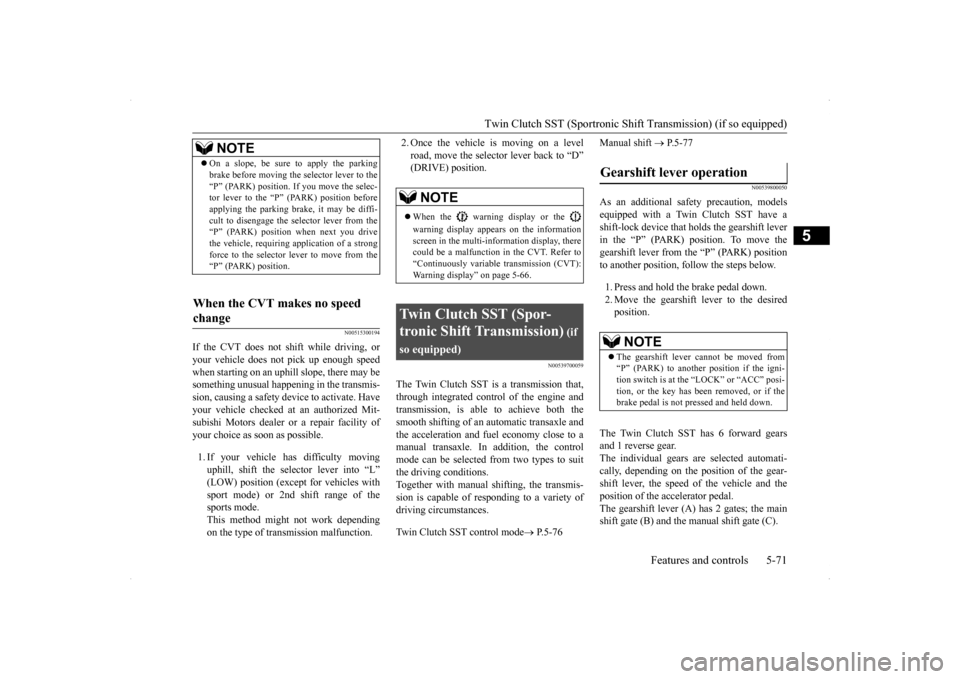
Twin Clutch SST (Sportronic Shif
t Transmission) (if so equipped) Features and controls 5-71
5
N00515300194
If the CVT does not shift while driving, or your vehicle does not pick up enough speed when starting on an uphill slope, there may be something unusual happening in the transmis-sion, causing a safety device to activate. Have your vehicle checked at an authorized Mit- subishi Motors dealer or a repair facility ofyour choice as soon as possible. 1. If your vehicle has difficulty moving uphill, shift the selector lever into ‚ÄúL‚ÄĚ (LOW) position (except for vehicles withsport mode) or 2nd shift range of the sports mode. This method might not work dependingon the type of transmission malfunction.
2. Once the vehicle is moving on a level road, move the selector lever back to ‚ÄúD‚ÄĚ (DRIVE) position.
N00539700059
The Twin Clutch SST is a transmission that,through integrated control of the engine and transmission, is able to achieve both thesmooth shifting of an automatic transaxle and the acceleration and fuel economy close to a manual transaxle. In addition, the controlmode can be selected from two types to suit the driving conditions. Together with manual shifting, the transmis-sion is capable of responding to a variety of driving circumstances. Twin Clutch SST control mode
Ôāģ P.5-76
Manual shift
Ôāģ P.5-77
N00539800050
As an additional safe
ty precaution, models
equipped with a Twin Clutch SST have ashift-lock device that holds the gearshift lever in the ‚ÄúP‚ÄĚ (PARK) position. To move the gearshift lever from the ‚ÄúP‚ÄĚ (PARK) positionto another position, follow the steps below. 1. Press and hold the brake pedal down. 2. Move the gearshift lever to the desired position.
The Twin Clutch SST has 6 forward gears and 1 reverse gear. The individual gears are selected automati-cally, depending on the position of the gear- shift lever, the speed of the vehicle and the position of the accelerator pedal.The gearshift lever (A) has 2 gates; the main shift gate (B) and the manual shift gate (C).
NOTE
ÔĀ¨ On a slope, be sure to apply the parking brake before moving the selector lever to the ‚ÄúP‚ÄĚ (PARK) position. If you move the selec- tor lever to the ‚ÄúP‚ÄĚ (PARK) position before applying the parking brake, it may be diffi-cult to disengage the selector lever from the ‚ÄúP‚ÄĚ (PARK) position when next you drive the vehicle, requiring application of a strongforce to the selector le
ver to move from the
‚ÄúP‚ÄĚ (PARK) position.
When the CVT makes no speed change
NOTE
ÔĀ¨ When the warning display or the warning display appears on the information screen in the multi-information display, therecould be a malfunction in the CVT. Refer to ‚ÄúContinuously variable transmission (CVT): Warning display‚ÄĚ on page 5-66.
Twin Clutch SST (Spor- tronic Shift Transmission)
(if
so equipped)
Gearshift lever operation
NOTE
ÔĀ¨ The gearshift lever cannot be moved from ‚ÄúP‚ÄĚ (PARK) to another position if the igni-tion switch is at the ‚ÄúLOCK‚ÄĚ or ‚ÄúACC‚ÄĚ posi- tion, or the key has been removed, or if the brake pedal is not pressed and held down.
Page 142 of 434
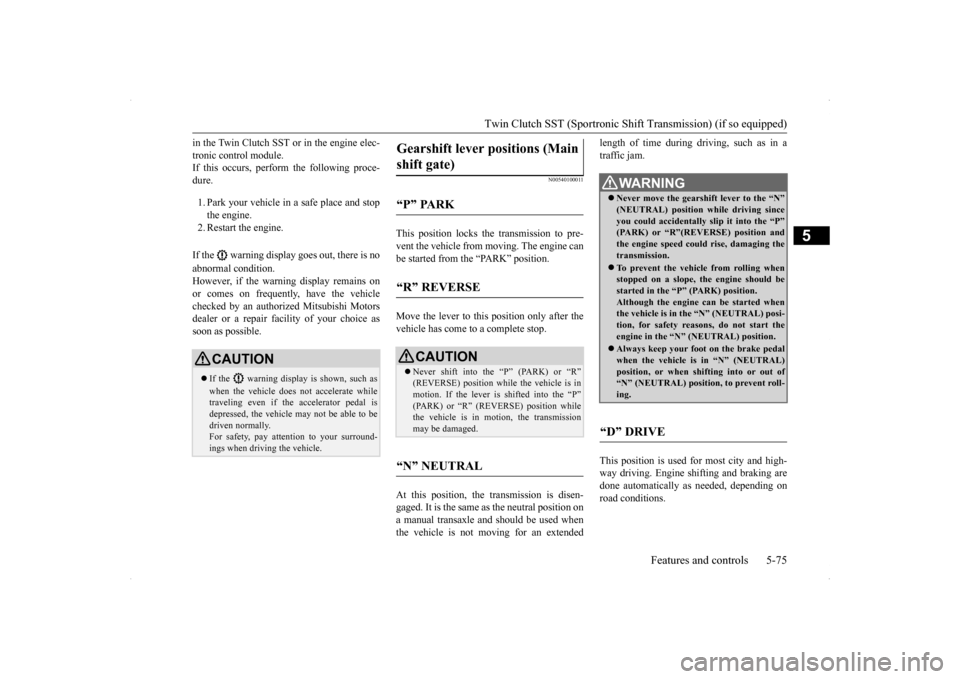
Twin Clutch SST (Sportronic Shif
t Transmission) (if so equipped) Features and controls 5-75
5
in the Twin Clutch SST or in the engine elec- tronic control module. If this occurs, perform the following proce- dure. 1. Park your vehicle in a safe place and stop the engine. 2. Restart the engine. If the warning display goes out, there is no abnormal condition. However, if the warning display remains onor comes on frequently, have the vehicle checked by an authorized Mitsubishi Motors dealer or a repair facility of your choice assoon as possible.
N00540100011
This position locks the transmission to pre-vent the vehicle from moving. The engine can be started from the ‚ÄúPARK‚ÄĚ position. Move the lever to this position only after the vehicle has come to a complete stop. At this position, the transmission is disen- gaged. It is the same as the neutral position on a manual transaxle and should be used whenthe vehicle is not moving for an extended
length of time during driving, such as in a traffic jam. This position is used for most city and high- way driving. Engine shifting and braking are done automatically as needed, depending onroad conditions.
CAUTIONÔĀ¨ If the warning display is shown, such as when the vehicle does not accelerate while traveling even if the accelerator pedal is depressed, the vehicle may not be able to be driven normally. For safety, pay attention to your surround- ings when driving the vehicle.
Gearshift lever positions (Main shift gate)
‚ÄúP‚ÄĚ PARK
‚ÄúR‚ÄĚ REVERSE
CAUTIONÔĀ¨ Never shift into the ‚ÄúP‚ÄĚ (PARK) or ‚ÄúR‚ÄĚ (REVERSE) position while the vehicle is in motion. If the lever is shifted into the ‚ÄúP‚ÄĚ (PARK) or ‚ÄúR‚ÄĚ (REVERSE) position whilethe vehicle is in motion, the transmission may be damaged.
‚ÄúN‚ÄĚ NEUTRAL
WA R N I N GÔĀ¨ Never move the gearshift lever to the ‚ÄúN‚ÄĚ (NEUTRAL) position while driving since you could accidentally slip it into the ‚ÄúP‚ÄĚ(PARK) or ‚ÄúR‚ÄĚ(REVERSE) position and the engine speed could rise, damaging the transmission.ÔĀ¨ To prevent the vehicle from rolling when stopped on a slope, the engine should bestarted in the ‚ÄúP‚ÄĚ (PARK) position. Although the engine can be started when the vehicle is in the ‚ÄúN‚ÄĚ (NEUTRAL) posi-tion, for safety reasons, do not start the engine in the ‚ÄúN‚ÄĚ (NEUTRAL) position.ÔĀ¨ Always keep your foot on the brake pedal when the vehicle is in ‚ÄúN‚ÄĚ (NEUTRAL) position, or when shifting into or out of‚ÄúN‚ÄĚ (NEUTRAL) position, to prevent roll- ing.
‚ÄúD‚ÄĚ DRIVE
Page 150 of 434
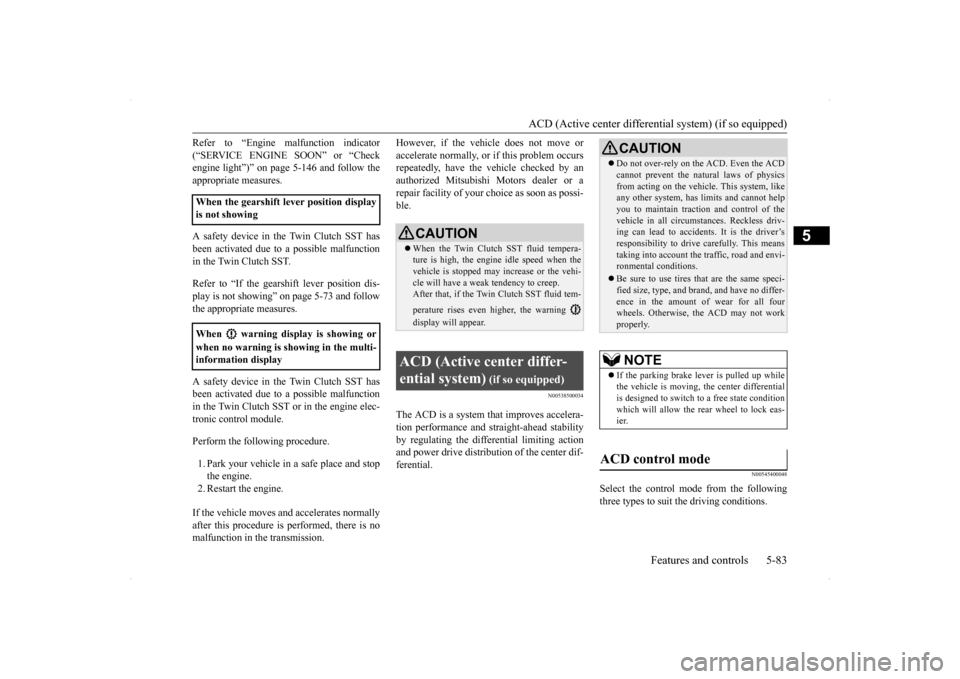
ACD (Active center differential system) (if so equipped)
Features and controls 5-83
5
Refer to ‚ÄúEngine malfunction indicator (‚ÄúSERVICE ENGINE SOON‚ÄĚ or ‚ÄúCheck engine light‚ÄĚ)‚ÄĚ on page 5-146 and follow the appropriate measures. A safety device in the Twin Clutch SST has been activated due to a possible malfunctionin the Twin Clutch SST. Refer to ‚ÄúIf the gearshift lever position dis- play is not showing‚ÄĚ on
page 5-73 and follow
the appropriate measures. A safety device in the Twin Clutch SST has been activated due to a possible malfunctionin the Twin Clutch SST or in the engine elec-tronic control module. Perform the following procedure.1. Park your vehicle in a safe place and stop the engine. 2. Restart the engine. If the vehicle moves and accelerates normally after this procedure is performed, there is no malfunction in the transmission.
However, if the vehicle does not move or accelerate normally, or if this problem occurs repeatedly, have the vehicle checked by an authorized Mitsubishi Motors dealer or arepair facility of your ch
oice as soon as possi-
ble.
N00538500034
The ACD is a system
that improves accelera-
tion performance and straight-ahead stabilityby regulating the differential limiting action and power drive distribution of the center dif- ferential.
N00545400048
Select the control mode from the followingthree types to suit the driving conditions.
When the gearshift lever position display is not showing When warning display is showing or when no warning is showing in the multi- information display
CAUTIONÔĀ¨ When the Twin Clutch SST fluid tempera- ture is high, the engine idle speed when the vehicle is stopped may increase or the vehi- cle will have a weak tendency to creep. After that, if the Twin Clutch SST fluid tem- perature rises even higher, the warning display will appear.
ACD (Active center differ- ential system)
(if so equipped)
CAUTIONÔĀ¨ Do not over-rely on th
e ACD. Even the ACD
cannot prevent the natural laws of physics from acting on the vehicle. This system, like any other system, has limits and cannot help you to maintain traction and control of thevehicle in all circumstances. Reckless driv- ing can lead to accidents. It is the driver‚Äôs responsibility to drive carefully. This meanstaking into account the traffic, road and envi- ronmental conditions.ÔĀ¨ Be sure to use tires that are the same speci- fied size, type, and brand, and have no differ- ence in the amount of wear for all fourwheels. Otherwise, the ACD may not work properly.NOTE
ÔĀ¨ If the parking brake lever is pulled up while the vehicle is moving, the center differential is designed to switch to a free state condition which will allow the rear wheel to lock eas-ier.
ACD control mode
Page 159 of 434
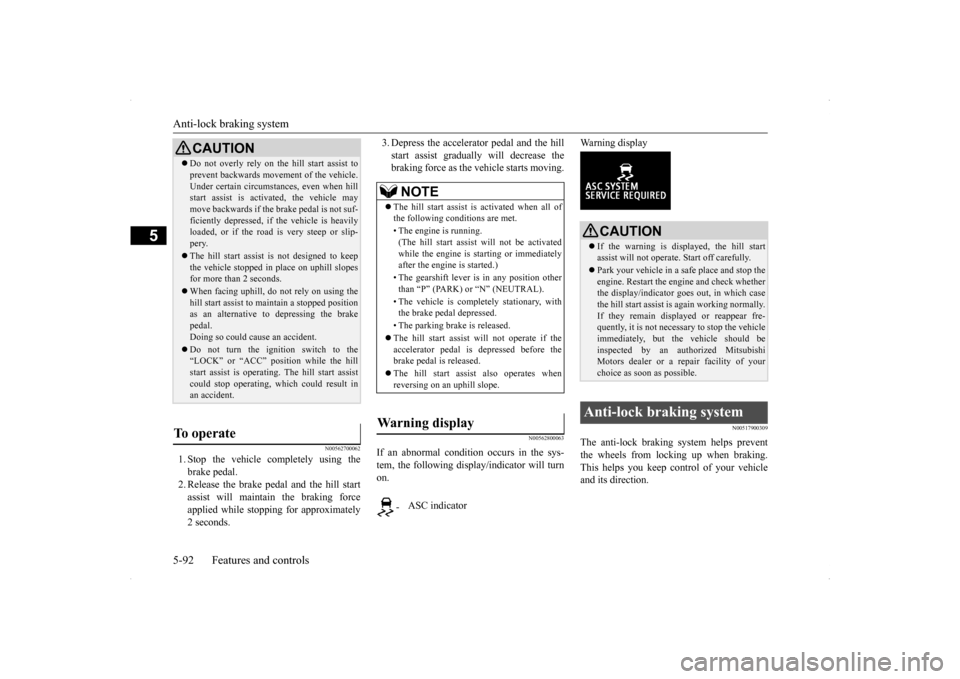
Anti-lock braking system 5-92 Features and controls
5
N00562700062
1. Stop the vehicle completely using the brake pedal.2. Release the brake pedal and the hill start assist will maintain the braking force applied while stopping for approximately2 seconds.
3. Depress the accelerator pedal and the hill start assist gradually will decrease the braking force as the vehicle starts moving.
N00562800063
If an abnormal condition occurs in the sys- tem, the following display/indicator will turnon.
Warning display
N00517900309
The anti-lock braking system helps prevent the wheels from locking up when braking.This helps you keep c
ontrol of your vehicle
and its direction.
CAUTIONÔĀ¨ Do not overly rely on the hill start assist to prevent backwards movement of the vehicle. Under certain circumstances, even when hill start assist is activated, the vehicle may move backwards if the brake pedal is not suf-ficiently depressed, if the vehicle is heavily loaded, or if the road is very steep or slip- pery.ÔĀ¨ The hill start assist is not designed to keep the vehicle stopped in place on uphill slopesfor more than 2 seconds.ÔĀ¨ When facing uphill, do
not rely on using the
hill start assist to maintain a stopped position as an alternative to depressing the brake pedal.Doing so could cause an accident.ÔĀ¨ Do not turn the ignition switch to the ‚ÄúLOCK‚ÄĚ or ‚ÄúACC‚ÄĚ position while the hill start assist is operating. The hill start assist could stop operating, which could result inan accident.
To operate
NOTE
ÔĀ¨ The hill start assist is activated when all of the following conditions are met. ‚ÄĘ The engine is running. (The hill start assist will not be activated while the engine is starting or immediatelyafter the engine is started.) ‚ÄĘ The gearshift lever is in any position other than ‚ÄúP‚ÄĚ (PARK) or ‚ÄúN‚ÄĚ (NEUTRAL). ‚ÄĘ The vehicle is completely stationary, with the brake pedal depressed. ‚ÄĘ The parking brake is released.ÔĀ¨ The hill start assist will not operate if the accelerator pedal is depressed before thebrake pedal is released. ÔĀ¨ The hill start assist also operates when reversing on an uphill slope.
Warning display
-
ASC indicator
CAUTIONÔĀ¨ If the warning is displayed, the hill start assist will not operate. Start off carefully.ÔĀ¨ Park your vehicle in a safe place and stop the engine. Restart the engine and check whether the display/indicator goes out, in which case the hill start assist is
again working normally.
If they remain displayed or reappear fre- quently, it is not necessary to stop the vehicle immediately, but the vehicle should beinspected by an authorized Mitsubishi Motors dealer or a repair facility of your choice as soon as possible.
Anti-lock braking system
Page 164 of 434
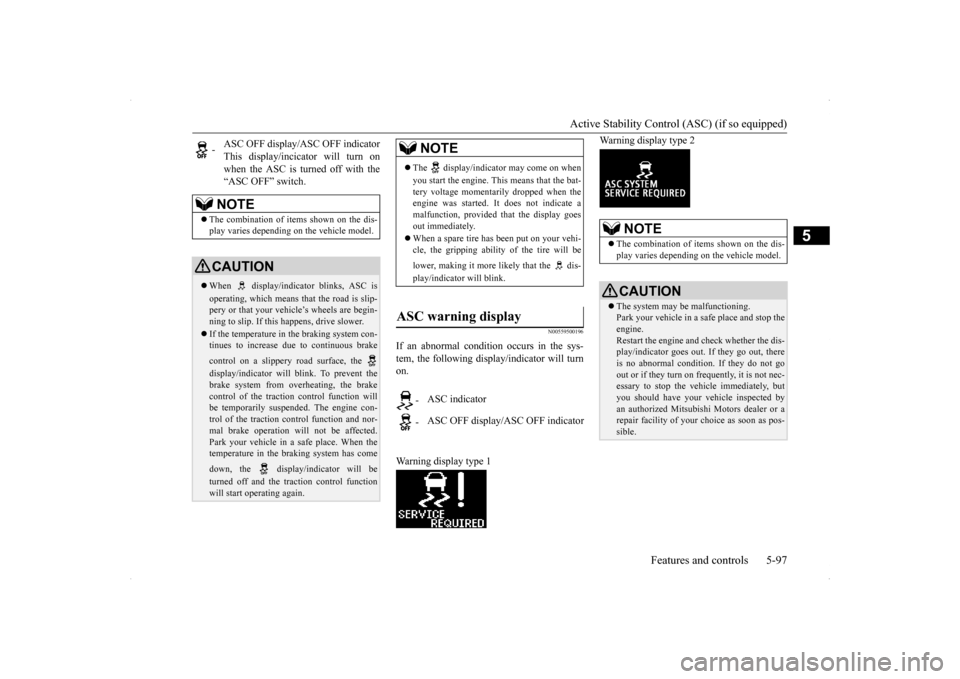
Active Stability Control (ASC) (if so equipped)
Features and controls 5-97
5
N00559500196
If an abnormal condition occurs in the sys- tem, the following display/indicator will turn on. Warning display type 1
Warning display type 2
-
ASC OFF display/ASC OFF indicator This display/incicator will turn onwhen the ASC is turned off with the ‚ÄúASC OFF‚ÄĚ switch.NOTE
ÔĀ¨ The combination of items shown on the dis- play varies depending on the vehicle model.CAUTIONÔĀ¨ When display/indicator blinks, ASC is operating, which means that the road is slip- pery or that your vehicle‚Äôs wheels are begin-ning to slip. If this happens, drive slower.ÔĀ¨ If the temperature in the braking system con- tinues to increase due to continuous brake control on a slippery road surface, the display/indicator will blink. To prevent the brake system from overheating, the brake control of the traction control function willbe temporarily suspended. The engine con- trol of the traction control function and nor- mal brake operation will not be affected. Park your vehicle in a safe place. When the temperature in the braking system has come down, the display/indicator will be turned off and the traction control function will start operating again.
NOTE
ÔĀ¨ The display/indicator may come on when you start the engine. This means that the bat- tery voltage momentarily dropped when the engine was started. It does not indicate amalfunction, provided that the display goes out immediately. ÔĀ¨ When a spare tire has been put on your vehi- cle, the gripping ability of the tire will be lower, making it more likely that the dis- play/indicator will blink.
ASC warning display
-
ASC indicator
-
ASC OFF display/ASC OFF indicator
NOTE
ÔĀ¨ The combination of items shown on the dis- play varies depending on the vehicle model.CAUTIONÔĀ¨ The system may be malfunctioning. Park your vehicle in a safe place and stop the engine. Restart the engine and check whether the dis- play/indicator goes out. If they go out, there is no abnormal condition.
If they do not go
out or if they turn on frequently, it is not nec- essary to stop the vehicle immediately, but you should have your vehicle inspected byan authorized Mitsubishi Motors dealer or a repair facility of your
choice as soon as pos-
sible.
Page 170 of 434
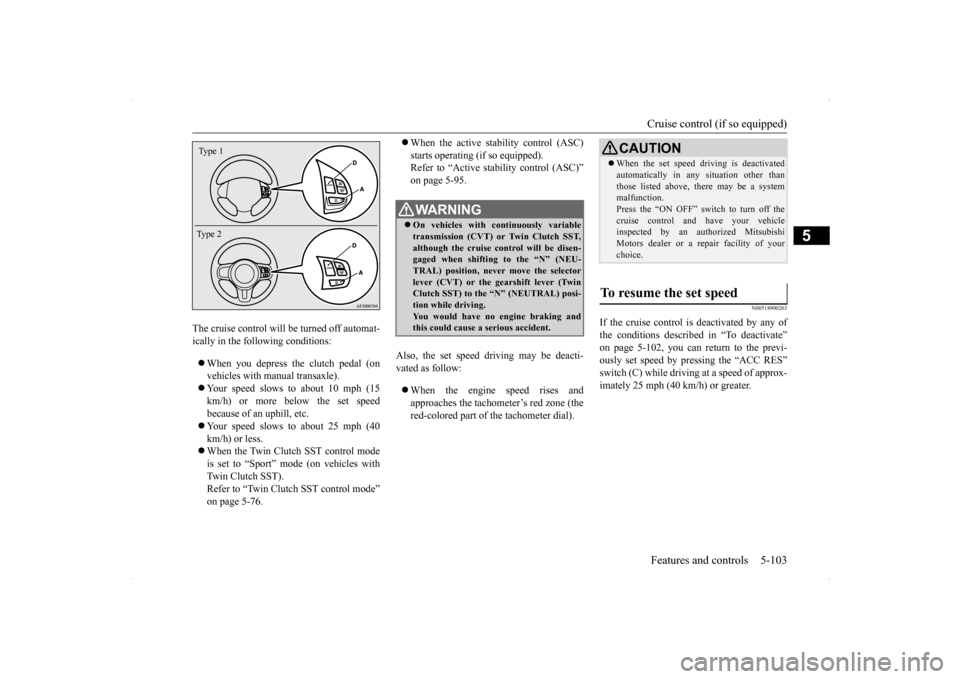
Cruise control (if so equipped) Features and controls 5-103
5
The cruise control will be turned off automat- ically in the following conditions: ÔĀ¨ When you depress the clutch pedal (on vehicles with manual transaxle). ÔĀ¨ Your speed slows to about 10 mph (15 km/h) or more below the set speedbecause of an uphill, etc. ÔĀ¨ Your speed slows to about 25 mph (40 km/h) or less.ÔĀ¨ When the Twin Clutch SST control mode is set to ‚ÄúSport‚ÄĚ mode (on vehicles with Twin Clutch SST).Refer to ‚ÄúTwin Clutch SST control mode‚ÄĚ on page 5-76.
ÔĀ¨ When the active stability control (ASC) starts operating (if so equipped). Refer to ‚ÄúActive stability control (ASC)‚ÄĚ on page 5-95.
Also, the set speed driving may be deacti- vated as follow: ÔĀ¨ When the engine speed rises and approaches the tachometer‚Äôs red zone (the red-colored part of the tachometer dial).
N00518900263
If the cruise control is deactivated by any ofthe conditions described in ‚ÄúTo deactivate‚ÄĚon page 5-102, you can return to the previ- ously set speed by pressing the ‚ÄúACC RES‚ÄĚ switch (C) while driving at a speed of approx-imately 25 mph (40 km/h) or greater.
Type 1 Type 2
WA R N I N GÔĀ¨ On vehicles with continuously variable transmission (CVT) or Twin Clutch SST,although the cruise control will be disen- gaged when shifting to the ‚ÄúN‚ÄĚ (NEU- TRAL) position, never move the selectorlever (CVT) or the gearshift lever (Twin Clutch SST) to the ‚ÄúN‚ÄĚ (NEUTRAL) posi- tion while driving.You would have no engine braking and this could cause a serious accident.
CAUTIONÔĀ¨ When the set speed driving is deactivated automatically in any situation other than those listed above, there may be a system malfunction. Press the ‚ÄúON OFF‚ÄĚ switch to turn off thecruise control and have your vehicle inspected by an authorized Mitsubishi Motors dealer or a repair facility of yourchoice.
To resume the set speed
Page 213 of 434
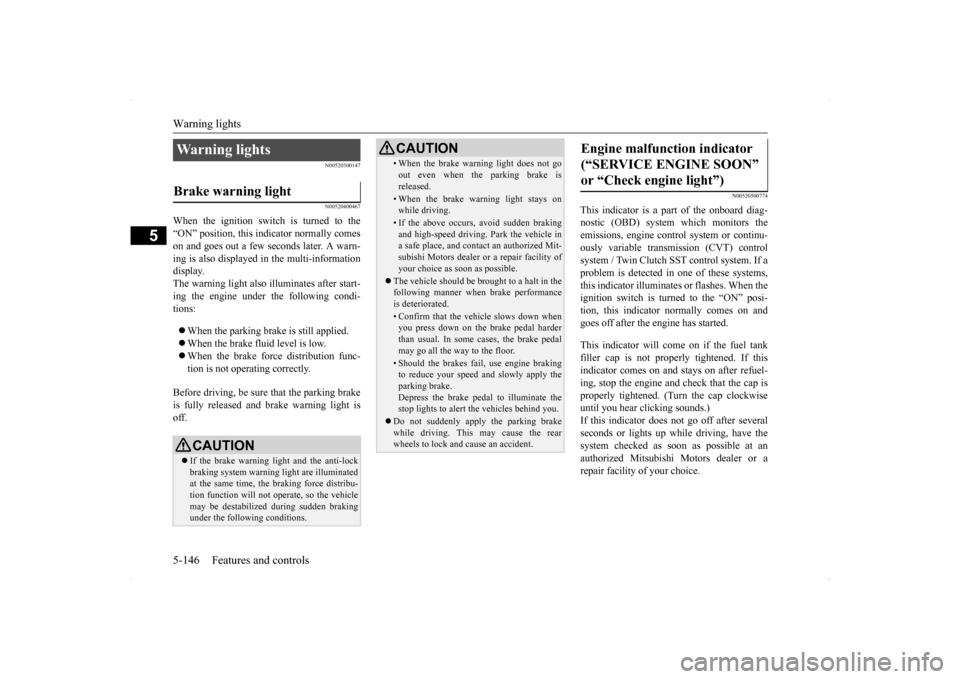
Warning lights 5-146 Features and controls
5
N00520300147 N00520400467
When the ignition switch is turned to the ‚ÄúON‚ÄĚ position, this indicator normally comeson and goes out a few seconds later. A warn- ing is also displayed in the multi-information display.The warning light also illuminates after start-ing the engine under the following condi- tions: ÔĀ¨ When the parking brake is still applied. ÔĀ¨ When the brake fluid level is low. ÔĀ¨ When the brake force distribution func- tion is not operating correctly.
Before driving, be sure that the parking brake is fully released and brake warning light isoff.
N00520500774
This indicator is a part of the onboard diag- nostic (OBD) system which monitors the emissions, engine contro
l system or continu-
ously variable transmission (CVT) control system / Twin Clutch SST control system. If a problem is detected in one of these systems,this indicator illuminates or flashes. When theignition switch is turned to the ‚ÄúON‚ÄĚ posi- tion, this indicator normally comes on and goes off after the engine has started. This indicator will come on if the fuel tank filler cap is not properly tightened. If this indicator comes on and stays on after refuel- ing, stop the engine and check that the cap isproperly tightened. (Turn the cap clockwise until you hear clicking sounds.) If this indicator does not go off after severalseconds or lights up while driving, have the system checked as soon as possible at an authorized Mitsubishi Motors dealer or arepair facility of your choice.
Warning lights Brake warning light
CAUTIONÔĀ¨ If the brake warning light and the anti-lock braking system warning light are illuminated at the same time, the braking force distribu-tion function will not operate, so the vehicle may be destabilized during sudden braking under the following conditions.
‚ÄĘ When the brake warning light does not go out even when the parking brake is released.‚ÄĘ When the brake warning light stays onwhile driving.‚ÄĘ If the above occurs, avoid sudden brakingand high-speed driving. Park the vehicle in a safe place, and contact an authorized Mit- subishi Motors dealer or a repair facility ofyour choice as soon as possible.
ÔĀ¨ The vehicle should be brought to a halt in the following manner when brake performance is deteriorated.‚ÄĘ Confirm that the vehicle slows down whenyou press down on the brake pedal harder than usual. In some cases, the brake pedalmay go all the way to the floor.‚ÄĘ Should the brakes fail, use engine brakingto reduce your speed and slowly apply the parking brake. Depress the brake pedal to illuminate thestop lights to alert the vehicles behind you.
ÔĀ¨ Do not suddenly apply the parking brake while driving. This may cause the rear wheels to lock and cause an accident.CAUTION
Engine malfunction indicator (‚ÄúSERVICE ENGINE SOON‚ÄĚ or ‚ÄúCheck engine light‚ÄĚ)
Page 216 of 434
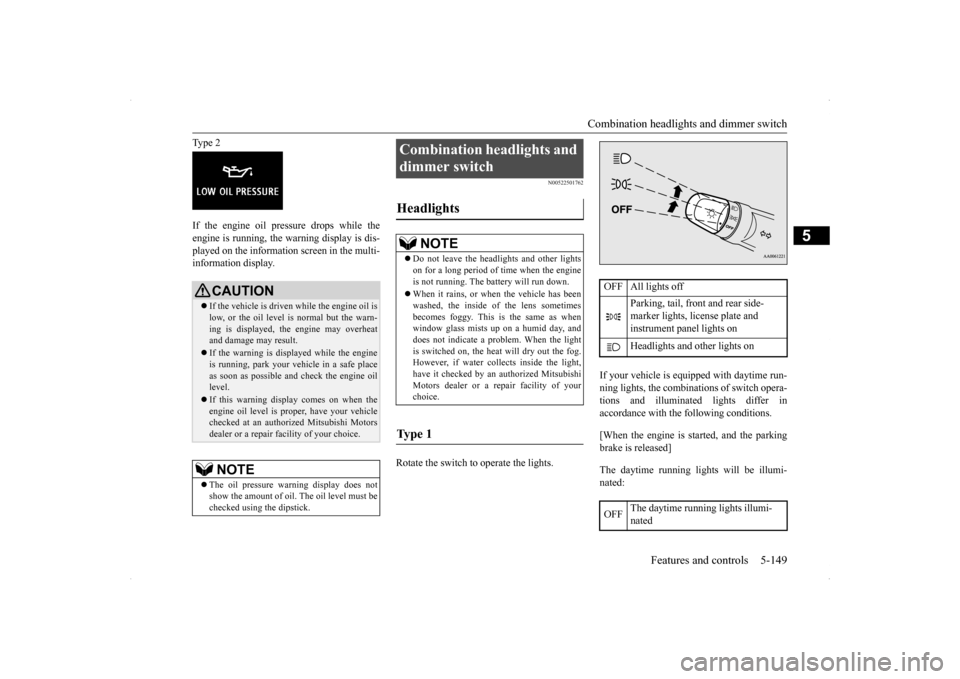
Combination headlights and dimmer switch
Features and controls 5-149
5
Type 2 If the engine oil pressure drops while the engine is running, the warning display is dis- played on the information screen in the multi-information display.
N00522501762
Rotate the switch to operate the lights.
If your vehicle is equipped with daytime run- ning lights, the combinations of switch opera- tions and illuminated lights differ inaccordance with the following conditions. [When the engine is started, and the parking brake is released] The daytime running lights will be illumi- nated:
CAUTIONÔĀ¨ If the vehicle is driven while the engine oil is low, or the oil level is normal but the warn- ing is displayed, the engine may overheat and damage may result.ÔĀ¨ If the warning is displayed while the engine is running, park your vehicle in a safe place as soon as possible and check the engine oil level.ÔĀ¨ If this warning display comes on when the engine oil level is proper, have your vehiclechecked at an authorized Mitsubishi Motors dealer or a repair facility of your choice.NOTE
ÔĀ¨ The oil pressure warning display does not show the amount of oil. The oil level must be checked using the dipstick.
Combination headlights and dimmer switch Headlights
NOTE
ÔĀ¨ Do not leave the headlights and other lights on for a long period of time when the engine is not running. The battery will run down. ÔĀ¨ When it rains, or when the vehicle has been washed, the inside of the lens sometimes becomes foggy. This is the same as whenwindow glass mists up on a humid day, and does not indicate a problem. When the light is switched on, the heat will dry out the fog.However, if water collects inside the light, have it checked by an authorized Mitsubishi Motors dealer or a repair facility of yourchoice.
Ty p e 1
OFF All lights off
Parking, tail, front and rear side- marker lights, license plate and instrument panel lights on Headlights and other lights on
OFF
The daytime running lights illumi- nated